|

Sam Benzacar of Anatech Electronics, an RF and microwave filter company, has published
his July 2023 newsletter that features his short op−ed entitled "Another Annoyance
for Radio Astronomers." In it, Sam discusses a subject I have highlighted a few
times, which is the interference issues being caused by the massive satellite
constellations being deployed around the Earth. Between
Starlink (SpaceX) and
Project Kuiper
(Amazon),
Guo Wang (China), and Europe planning one of its own, as many as 100,000
satellites ultimately (maybe more, with >4,000 already deployed), many in low
Earth orbit (LEO), could be blocking radio frequency, infrared, visible light,
ultraviolet, and x-ray information from cleanly reaching terrestrial astronomy
telescopes. Ingenuous solutions to mitigating scintillation effects of the
atmosphere have been devised, but no similar method can be used for satellite
interference. Sam's write-up has to do specifically with the newly discovered
RFI being created from the satellites themselves - it appears in bands
specifically reserved for radio astronomy. As you know, uncorrelated inband
interference is very difficult to mitigate. This problem is forcing astronomers
to plan space-based observatories to do the job now done on Earth, causing costs
and risks to go way up. Servicing an orbiting telescope is virtually impossible
now that the
Space Shuttle program died in 2011 (recall the HST's
optics were repaired during a
Shuttle mission).
A Word from Sam Benzacar - Another Annoyance for Radio Astronomers
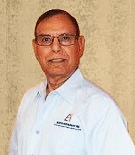 By Sam Benzacar By Sam Benzacar
The rapidly growing number of satellites in low Earth orbit (LEO) may have enormous
benefits for delivering broadband virtually anywhere, but it's wreaking havoc with
radio astronomers. Their first concern was their brightness in the sky, and now
they've discovered another potential impediment: electromagnetic emissions. This
assessment comes from a report published in Astronomy & Astrophysics and authored
by institutions including the Max Planck Institute for Radio Astronomy in Bonn,
Germany. Using the Low-Frequency Array (LOFAR) telescope in the Netherlands to observe
68 SpaceX Starlink satellites, they detected radiation between 110 and 188 MHz from
47 of them. Unfortunately, these frequencies fall into the spectral region between
150.5 and 153 MHz, which is protected for radio astronomy by the International Telecommunications
Union.
Although the received levels are incredibly low - a few microwatts or around a
million times weaker than the emissions from a mobile phone - they're still strong
enough to be detected by the sensitive receivers of radio telescopes. SpaceX is
not in breach of any rules because, unlike their terrestrial counterparts, satellite
radiation is not regulated (yet). The company has been in contact with the scientific
community about how to remedy the issue. It has already introduced changes to its
next satellites that could mitigate their impact on astronomical projects.
The authors focused on SpaceX because it has the most broadband communications
LEO satellites LEO by far, which at the moment is about 4,700. The company has regulatory
approval to deploy 12,000 and has filed for approval to launch another 30,000 to
reach its goal of 42,000.
The problem the scientists have observed will only become more acute in the future
because the era of satellite-based broadband services has just begun, and other
players in this industry have yet to launch their satellite constellations. Although
estimates vary, the number of spacecraft in LEO or other orbits could ultimately
reach 100,000 by around the end of the decade, a number that has been called sustainable.
Radio observatories have long located their locations in some of Earth's most
remote places. For example, next-generation large-scale radio observatories such
as the Square Kilometer Array Observatory (SKAO) are being built in two sparsely
populated areas in Australia and South Africa where no terrestrial communications,
TV, or radio use is allowed.
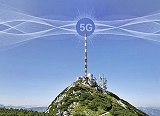 Over-the-Air TV via 5G Over-the-Air TV via 5G
The Federal Communications Commission has authorized WWOO-LD Boston to use 5G
broadcasting to offer free over-the-air (OTA) TV. This TV service will allow smartphones,
tablets, and any other device with a 5G chipset to receive TV signals. Bringing
broadcast to 5G could help reduce congestion because rather than a "one-to-one model,"
it uses a one-to-many model. WWOO will broadcast traditional TV signals in 5G and
work with public safety to provide video and data services to first responders.
As part of the FCC approval, WWOO has until January 2024 to complete its testing.
LiFi Gets FCC OK
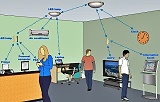 The IEEE has approved IEEE 802.11bb, which is an amendment to the Wi-Fi specification
that uses visible and infrared light. The amendment describes the changes required
to physical and medium access control layers to allow 802.11 wireless networking
via light source modulation. The LiFi spec calls for bidirectional transmission
in the 800 to 1,000 nm band with a minimum throughput of 10 Mb/s and a maximum of
9.6 Gb/s at the access point. As LiFi access points have a limited field of view,
a network can be set up so pools of LED light can provide network access only to
those within them. This makes the technology secure as the light is highly restricted,
which is why it's already being used in military facilities. The IEEE has approved IEEE 802.11bb, which is an amendment to the Wi-Fi specification
that uses visible and infrared light. The amendment describes the changes required
to physical and medium access control layers to allow 802.11 wireless networking
via light source modulation. The LiFi spec calls for bidirectional transmission
in the 800 to 1,000 nm band with a minimum throughput of 10 Mb/s and a maximum of
9.6 Gb/s at the access point. As LiFi access points have a limited field of view,
a network can be set up so pools of LED light can provide network access only to
those within them. This makes the technology secure as the light is highly restricted,
which is why it's already being used in military facilities.
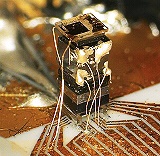 NIST, Georgia Tech Build Tiny Atomic Clock NIST, Georgia Tech Build Tiny Atomic Clock
NIST and researchers at Georgia Tech have created the first chip-scale beam clock,
which is about the size of a piece of sushi and uses very little power. It can run
on batteries, making it suitable for use when GPS is unavailable. The clock is currently
a prototype, and initial tests show it is slightly less accurate than existing chip-scale
atomic clocks. However, the researchers are confident that they can improve the
clock's accuracy by a factor of 10 and exceed the stability of existing clocks by
100 times over one week. The clock could have several applications, including navigation,
timing, and metrology.
PA May Let aAll Cops Use Speed Radar
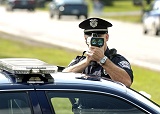 Pennsylvania is the only state that prohibits municipal police from using radar
to enforce speed limits, but the Pennsylvania House of Representatives is considering
a bill that aims to change that. Since 1961 only state troopers can use radar, and
local police are limited to VASCAR, which measures the time it takes for a vehicle
to travel between two points. Under the proposed law, local police could use radar
to catch speeders, but only if the driver is going at least 10 mph over the speed
limit. In work zones, the threshold would be 5 mph. The bill has raised the concern
that police could use radar as a revenue generator, so the bill only allows written
warnings for violations during the first 90 days of enforcement. It would also require
the officer to be in or near a clearly marked police vehicle. Pennsylvania is the only state that prohibits municipal police from using radar
to enforce speed limits, but the Pennsylvania House of Representatives is considering
a bill that aims to change that. Since 1961 only state troopers can use radar, and
local police are limited to VASCAR, which measures the time it takes for a vehicle
to travel between two points. Under the proposed law, local police could use radar
to catch speeders, but only if the driver is going at least 10 mph over the speed
limit. In work zones, the threshold would be 5 mph. The bill has raised the concern
that police could use radar as a revenue generator, so the bill only allows written
warnings for violations during the first 90 days of enforcement. It would also require
the officer to be in or near a clearly marked police vehicle.
Anatech Electronics Introduces a New Line of Suspended
Stripline and Waveguide Type RF Filters
Check out Our Filter Products
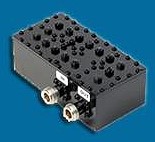
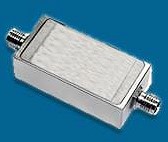
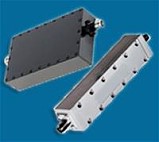
Cavity Band Pass Filters
LC Band Pass Filters Cavity Bandstop/Notch Filter
About Anatech Electronics
Anatech Electronics, Inc. (AEI) specializes in the design and manufacture of
standard and custom RF and microwave filters and other passive components and subsystems
employed in commercial, industrial, and aerospace and applications. Products are
available from an operating frequency range of 10 kHz to 30 GHz and include cavity,
ceramic, crystal, LC, and surface acoustic wave (SAW), as well as power combiners/dividers,
duplexers and diplexers, directional couplers, terminations, attenuators, circulators,
EMI filters, and lightning arrestors. The company's custom products and capabilities
are available at www.anatechelectronics.com.
Contact:
Anatech Electronics, Inc.
70 Outwater Lane
Garfield, NJ 07026
(973)
772-4242
sales@anatechelectronics.com
Posted July 25, 2023
|